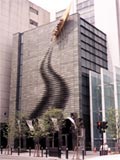Drowning in Support?
Back to Contents of Issue: July 2001
|
|
|
|
by Mark McCracken |
|
 "I THINK THEY'VE GOT enough buildings now," flatly notes Nathan Bryan, president of Osaka-based Gaijins.com, when asked about the state of business-support centers and incubators in Kansai. Some might argue that was true even before the City of Osaka built the $140 million Business Innovation Center Osaka. "I THINK THEY'VE GOT enough buildings now," flatly notes Nathan Bryan, president of Osaka-based Gaijins.com, when asked about the state of business-support centers and incubators in Kansai. Some might argue that was true even before the City of Osaka built the $140 million Business Innovation Center Osaka.
The 18-story, 3-basement Innovation Center (www.b-platz.ne.jp) opened in January in the heart of Osaka's business district (Sakaisuji Honmachi). Tenants include the Start-Up Business Office, the Credit Guarantee Corporation of Osaka, and the Entrepreneurial Museum of Challenge and Innovation. The building's Small and Medium-Sized Business Support Plaza has an information center, and there are financial and consulting services on the second floor. The center also has plenty of event halls and meeting and training rooms for rent. It's all very nice, but, as we noted in the March 2001 issue, the entire Kansai area is drowning in a sea of business-support and tech incubators, more than the number of actual entrepreneurs would seem to justify. (See "Click Kansai for E-Commerce.") The taxpayer-backed Innovation Center, with an annual operating budget of over ¥1 billion, a five-story open entrance area, and a bright yellow boat sculpture high above the entrance, is to some more a monument to pork-barrel spending than an aid to entrepreneurialism. "When I first heard about it," Bryan says, "I was thinking, 'OK great, another project, another bunch of taxpayers' money that's being wasted.'" But Bryan thinks that with the Innovation Center the City of Osaka has -- finally -- made a place that people are actually making use of. "I think it's one of the better projects that the Osaka City Government has been able to put together," he says. "It's very centrally located. It has a lot of usable spaces and rooms. People are using it -- as opposed to a lot of the other works and projects that the government has put together, where they spend a lot of money and nobody uses it." "This incubating facility will be a better supporting center for new businesses in Osaka than many public facilities in other cities," agrees Youko Koyama, chief marketing officer at Dos Tigres, a supporting member of the Innovation Center. Koyama, however, declined to comment on whether the building is taxpayer money well spent.
Shozo Fujita, deputy executive director of the American Chamber of Commerce in Japan (Kansai branch) and an Osaka resident, says it's difficult to say whether the tax money was used wisely. He's impressed with the building, though, and is considering using the place for a program or seminar. "We've been using hotels for programs because our programs are at night, but I'm thinking about holding some programs during the day. I think facilities at the Business Innovation Center are better." But are those facilities any better than the ones at, say, iMedio, the incubator opened in March 1999 in the nearby Asia Trade Center? And are not iMedio and the Innovation Center -- both taxpayer-backed and operated by the Osaka Urban Industry Promotion Center -- now competing against each other? No, says Maiko Mori of the Osaka Urban Industry Promotion Center. "Each has its own services and targets." iMedio, Mori says, is targeted at people and companies in multimedia, to whom it offers seminars, incubation offices, and low-rent multimedia studios. "All its services are concerned with the field of multimedia. [In contrast], the Business Innovation Center is targeted at medium and small companies. iMedio doesn't have consulting services such as business management, cash management, and so on, which the Business Innovation Center has." Still, the amount of money being spent on these centers is hard for some taxpayers to swallow. And the yellow boat doesn't help matters. Osaka resident Motomi Umeki asks, "Why is there a boat on the building? It's a waste of tax money, I think." Others argue that it's not more buildings, but truly useful services that are needed, like teaching startups business basics. "Setting up a company, running a company, getting funding for a company, hiring -- basic skills," says Bryan. "If you can't actually set up and run a company, no matter how good you are at doing something, as soon as you grow beyond yourself, you're going to go under." As for the yellow boat sculpture, Bryan says: "A lot of people don't really understand the boat. But it's a landmark. People remember the building." Whether that's good or bad remains to be seen. |
|
Note: The function "email this page" is currently not supported for this page.


 Masaki Yoshida of Akinai-aid, a startup advisory service backed by the Osaka government (
Masaki Yoshida of Akinai-aid, a startup advisory service backed by the Osaka government (


